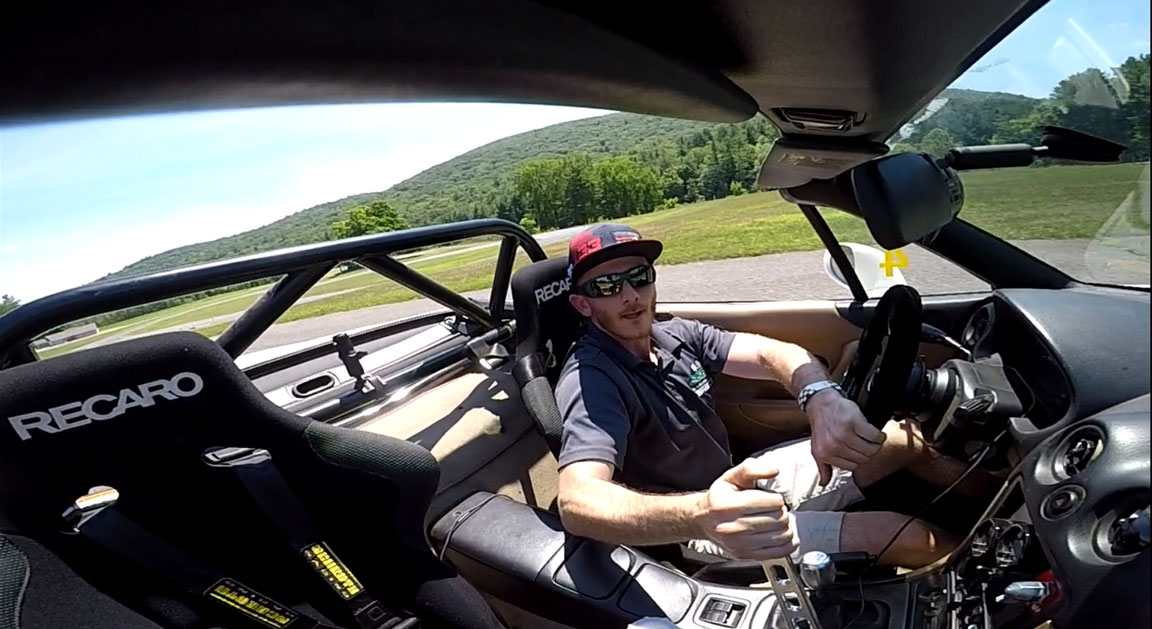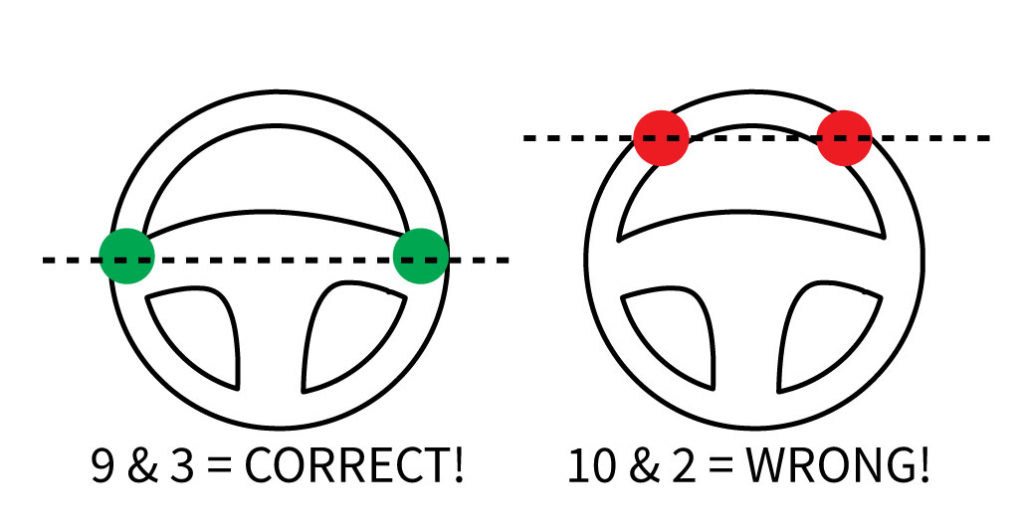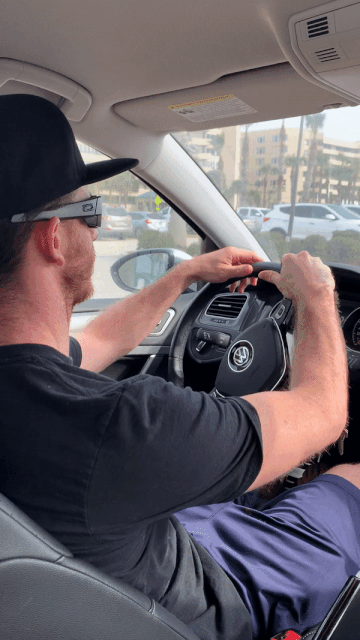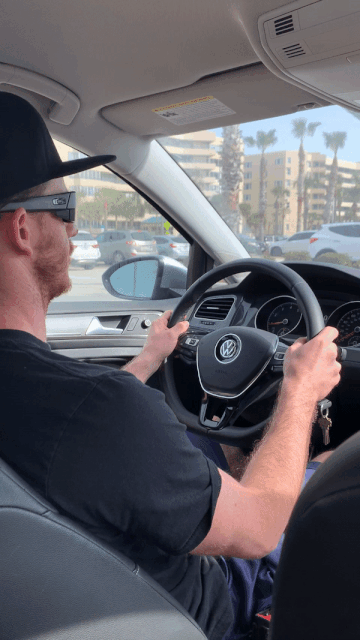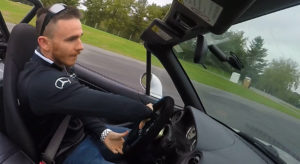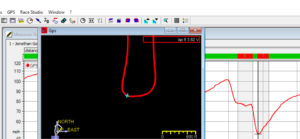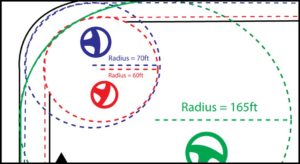“I’m not sure what to do with my hands!”
– Ricky Bobby from the racing movie “Talladega Nights” said it right.
Although he only said that because he was intimated by the camera, he brings up a good point.
As racers, we talk a lot about footwork, and rightfully so! But you don’t hear much about how to steer with good technique.
In this article, I will answer Ricky’s question about “what to do with your hands” and go into what I believe to be proper steering technique.
Mental Approach To Steering
I like to think of the steering wheel as a “front axle direction pointer.” That is, turning the steering wheel does not necessarily mean that the car will turn too. In racing, we run into this a lot.
Another analogy is to think of the front tires like a rudder on a boat. A rudder only turns the boat if it’s in the water. It’s useless above it! A tire on a car is much in the same way, that it needs to be loaded up properly to actually stick to the road and initiate the direction change.
It’s important to know that any time you are turning the steering wheel you are only asking the car to turn. The car will actually turn only if it wants (if the physics warrant.)
Whether or not it actually turns is up to the adhesion between the tire and road surface at a given moment.
During the time of any steering input, you are asking the car to “caster up” not only changing the suspension geometry, but also asking for grip from the friction circle to be used for changing direction.
As you steer more and more, you lose the ability to either decelerate or accelerate if you should choose. Steering is a taxing process that slows us down, wears out tires, and gives the driver less options should they choose to either stop on a dime (street) or get out of a corner quickly (racing.)
Steering Wheel Position Determines Pedal Position.
We all know we can go faster on the highway than we can in a parking garage, and the only reason that’s true is because of how much we have to turn the steering wheel.
On the highway you’re more or less straight, allowing the driver the ability to put the foot down (note, either foot!) But turning a 180 in a parking garage makes it really difficult to build up any sort of speed. This is a direct result of steering wheel position.
The very admission of “I wanna go fast” like in racing, means you had better find a way to steer less than your competitors if you want to beat them!
Why Should My Hands Be At 9 & 3?
When referring to where we place our hands on the steering wheel it’s common to use the clock face as an analogy.
Having your hands at “9 & 3” means that your hands are on the very left and very right side of the steering wheel, with a horizontal line dividing the top half and lower half into equal spaces.
With proper hand positioning, your hands will occupy the largest diameter possible on the wheel.
This is ideal! It allows for the widest possible range of steering angle before you have to take your hands off the wheel to reposition for turning the wheel another turn.
It means that I can turn further to the left and further to the right without repositioning my hands than someone who held the wheel at 10 & 2 because they would not be holding the wheel at it’s largest diameter.
Are You A Pusher or a Puller?
If I asked you “When you turn, do you push or pull on the steering wheel?” would you know what I meant? To explain this, let me create the example of this be a 90 degree, right hand turn.
The question I have is, do you push up on the steering wheel turning clockwise with your left hand?
Or, do you pull the steering wheel down and clockwise with your right hand? This matters more than you think!
Many of us instinctively do a percentage of both but typically drivers are more dominant with one than the other. It’s good to become accustomed with what you do now so that as you read on you can decide if you want to try something different 🙂
I prefer to “push” on the steering wheel. Here’s why.
In a self analysis, I find that I like to push by a factor of about 90% and pull by a factor of about 10%.
The reason why comes down to seating position. More specifically, it has to do with driver POSTURE.
We all know it’s important to “feel” the car through the seat of your pants.
Are we more likely to “feel” the car better if we are pushing ourselves INTO the seat or if we are pulling ourselves OUT of it?
By pulling down on the steering wheel to turn (as oppose to pushing up) we are activating our Back and Biceps muscles to do the work. By doing this, we are essentially pulling ourselves OUT of the seat, or at least activating the muscles that, if flexed hard enough, would pull us out of the seat.
But, by pushing up and against the steering wheel, we are firmly planting ourselves INTO the seat! This will result in a driver with a firmer core and more stable base, one who can feel the subtle messages the car is sending through the seat of the pants more accurately.
Further, the driver that is pushing up on the wheel will come from a place of increased stability to operate fine, detailed inputs to the steering wheel.
It’s my belief that a 90% “push” on the steering wheel is the way to go and I teach my students this way.
The 10% pull (thanks for asking) gives me the ability to completely relax the limb of the inside arm, giving me ultimate control over fingertips for super fine adjustments of the wheel.
The Great “Hand Over Hand” vs. “Shuffle Steer” Debacle
First, let me show you what each technique actually IS so we are all on the same page.
Shuffle Steering Explained
Shuffle steering is when you slide your hands around the steering wheel, never letting your arms cross over the centerline of the wheel, re-grabbing the wheel twice per 360-degree revolution.
Hand over Hand Explained
Hand over hand steering is when you maintain one hand on the same spot on the wheel, and eventually move one arm out of the way of the other so it can pass by to re-grab the wheel once in a 360-degree revolution.
Hand over hand, done correctly and at speed, looks like this:
Notice how I turn my head depending on where my front tires are pointed. It’s important to keep this relationship between the eyes and the hands, even while stationary, like in this video clip. For more information on this, you can read my article on “Eyework.”
Which steering technique should I use?
A professional race car driver is really good at knowing where their front tires are pointed at all times.
To be good at this, one steering technique is clearly better than the other, thanks to something called muscle memory.
Muscle Memory
In order to get really good at knowing where your front tires are pointed at any given moment, you must develop muscle memory as a reference point.
This means that “every time my hands are HERE, the front tires are pointed HERE.” Each degree of steering angle should have an exclusive positioning of the hands and limbs that is unique to that angle of steering only.
Any time you take your hands off of the steering wheel while turning (cough cough, shuffle steering) you will inevitably re-grab it in a different spot each time.
Letting go of the wheel is risky business because it will render muscle memory useless as there is no longer a correlation between where your hands are and where the front tires are pointed.
Remember, if the goal is to build good communication between your brain and your hands to understand where your front tires are pointed at all times, then your brain needs to register that “when my hands are here, the front tires are pointed here.”
This is Why Shuffle Steering Sucks
Truthfully, there aren’t any real advantages to shuffle steering. The only exception worth mentioning is that with your street driving, shuffle steering keeps your arm and hand away from the airbag.
Steer With The Ball Of Your Hand
Many people think of the steering wheel as something you “grab” or “hold on to.”
I think it’s something you push against with the palm (or ball) of your hand.
When I maintain contact with the steering wheel, it’s through a pushing motion through the ball of my hand and against the steering wheel where I create a bit of tension, pushing myself into the seat. My fingers do “droop” over the wheel but that’s only where they rest. They are not “grabbing” the wheel.
By using technique, I am always able to keep my hand at the same spot on the wheel (either 9 or 3) on the wheel through multiple full turns of the wheel.
On left hand turns, I push my right hand up on the steering wheel from the 3 o’clock position. On right hand turns, I push up with my left hand from the 9 o’clock position.
Of course, if we are going to keep our hands on the same spot on the wheel AND perform multiple turns of the wheel, this means have to be steering one handed some of the time.
This is ok, because I find it of more value to be super accustomed through muscle memory to where your front tires are pointed, than it is to have both hands on the wheel at all times.
In a left-hand turn, I push up with my right hand and once my left hand is in the way, I remove it from the wheel and keep “palming” and pushing against the wheel with my right hand in the 3 o’clock position as I turn counterclockwise.
In a right-hand turn, I will leave my hand at the 9 o’clock position, push the steering up with my left hand “palming” the steering wheel and pushing myself into the seat. Once I turn far enough where my arms are crossed, I let go with my right hand and keep palming clockwise with my left (all from the 9 o’clock position and never releasing) until the desired steering angle is achieved.
I never “hold on” to the steering wheel through the steering process, I just pushing against it with the palm of my hand.
Conclusion
I hope this enlightens you on the importance of proper steering technique and why it’s important to think twice about how you steer. It matters more than you think, and without good technique you’ll never unlock your full potential on how to “feel the car” through your hands.
You need to have a system in place that makes your brain know that “when my hands are here, the front tires are pointed here.
ABOUT THE AUTHOR
JONATHAN GORING
From 2006 Skip Barber National Champion to 2015 Spec Miata SCCA Runoffs Champion, and with the 2008 IMSA Lites title in between, I’ve been in the racing scene for quite some time. I’ve been fortunate to race against (and beat sometimes) the best drivers in the world currently racing in various top level motorsports.
I’m very passionate about the art/science of performance driving and want to share that passion with you.
WANT TO DRIVE FASTER THAN EVER?
Join my email list for monthly articles, driving tips, exclusive announcements on new things I’m working on and wisdom delivered straight to your inbox! You can unsubscribe at any time.
We value your privacy and will never share your personal information.

